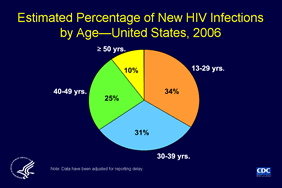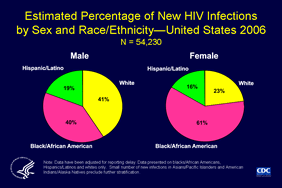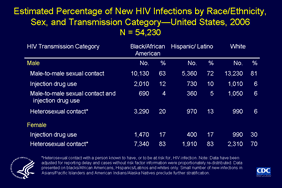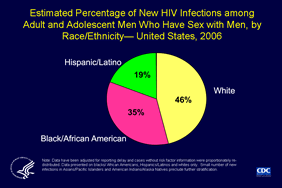| |
LEGEND:
 |
 |
|
Link to a PDF document |
 |
 |
|
Link to non-governmental site and does not
necessarily represent the views of the CDC |

|
 |
| Adobe
Acrobat (TM) Reader needs to be installed on
your computer in order to read documents in PDF format.
Download the Reader.
|
|
 |
 |
 |

| 
|
HIV Incidence 2006 |
 |
 |
|
Instructions for downloading and using
HIV/AIDS surveillance slides.
Download the
complete slide set:
While the content is in the public domain and
no copyright restriction applies,
we do ask that users preserve the slides in
their current format and cite CDC as the
source.
|

Slide 3
Estimated Percentage of New HIV Infections
by Sex—United States, 2006
PDF
File
 or
PPT
File or
PPT
File |
|

Slide 4
Estimated Percentage of New HIV Infections by Race/Ethnicity—United States, 2006
PDF
File
 or
PPT
File or
PPT
File |
|

Slide 5
Estimated Rate of New HIV Infections by Race/Ethnicity—United States, 2006
PDF
File
 or
PPT
File or
PPT
File |
|

Slide 6
Estimated Percentage of New HIV Infections by Transmission Category—United States, 2006
PDF
File
 or
PPT
File or
PPT
File |
|

Slide 7
Estimated Percentage of New HIV Infections
by Age—United States, 2006
PDF
File
 or
PPT
File or
PPT
File |
|

Slide 8
Estimated Percentage of New HIV Infections by Sex and Race/Ethnicity—United States 2006 N = 54,230
PDF
File
 or
PPT
File
or
PPT
File |
|

Slide 9
Estimated Rate of New HIV Infections by Sex and Race/Ethnicity—United States, 2006
N = 54,230
PDF
File
 or
PPT
File or
PPT
File |
|

Slide 10
Estimated Percentage of New HIV Infections by Race/Ethnicity, Sex and Age—United States, 2006 N = 54,230
PDF
File
 or
PPT
File or
PPT
File |
|

Slide 11
Estimated Percentage of New HIV Infections by Sex and Transmission Category—United States, 2006 N = 54,230
PDF
File
 or
PPT
File or
PPT
File |
|

Slide 12
Estimated Percentage of New HIV Infections by Race/Ethnicity, Sex, and Transmission Category—United States, 2006 N = 54,230
PDF
File
 or
PPT
File or
PPT
File |
|

Slide 13
Estimated Percentage of New HIV Infections among Adult and Adolescent Men Who Have Sex with Men, by Race/Ethnicity— United States, 2006
PDF
File
 or
PPT
File or
PPT
File |
|

Slide 14
Estimated Number of New HIV Infections among Adult and Adolescent Men Who Have Sex with Men, by Race/Ethnicity and Age Group—United States, 2006 N = 28,700
PDF
File
 or
PPT
File or
PPT
File |
|
|
|
|